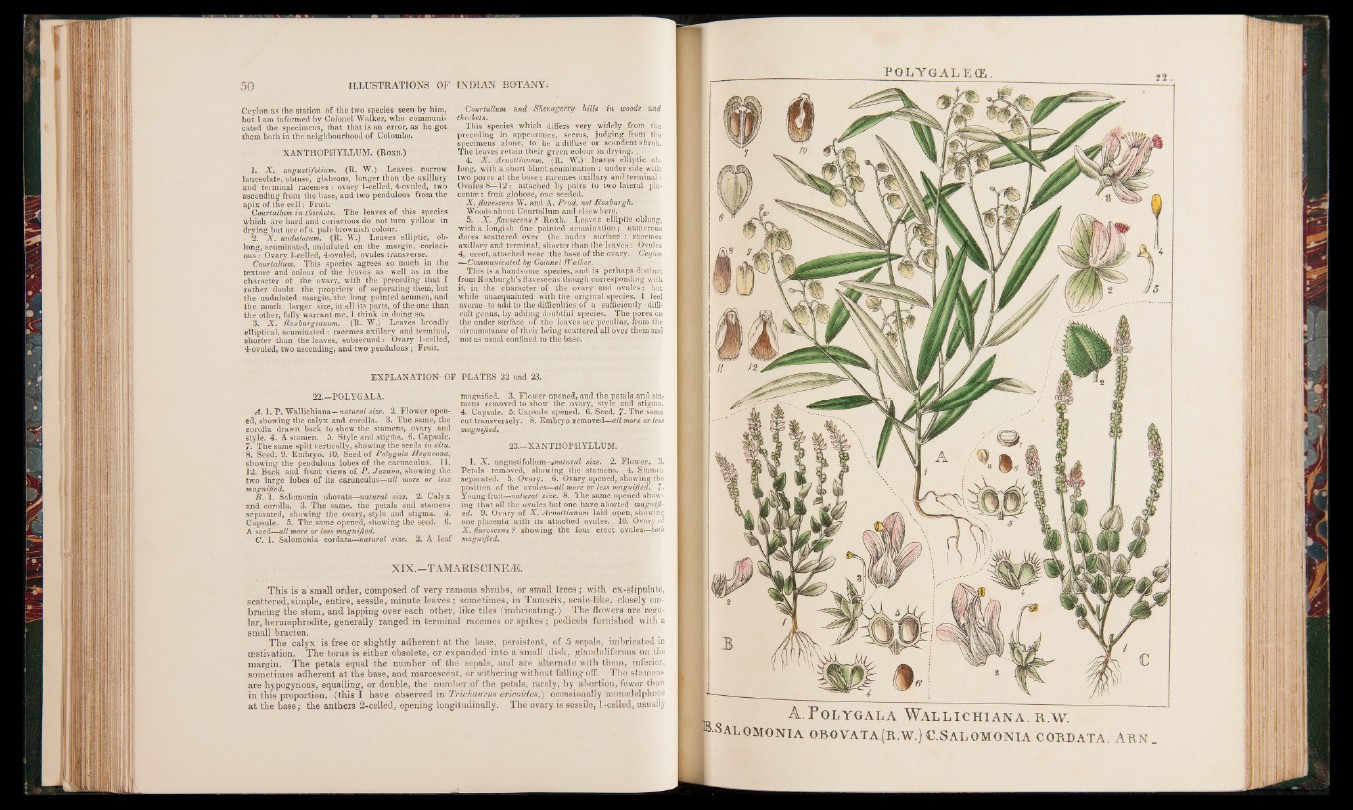
Ceylon as the station of the two species seen by him,
but I am informed by Colonel Walker, who communicated
the specimens, that that is an error, as he got
them both in the neighbourhood of Colombo.
XANTHOPHYLLUM. (Roxb.)
1. X . angustifolium. (R. W.) Leaves narrow
lanceolate, obtuse, glabrous, longer than the axillary
and terminal racemes : ovary l-celled, 4-ovuled, two
ascending from the base, and two pendulous from the
apix of the c e ll: Fruit.
Couriallum in thickets. The leaves of this species
which are hard and coriacious do not turn yellow in
drying but are of a pale brownish colour.
2. X . undulatum. (R. W.) Leaves elliptic, oblong,
acuminated, undulated on the margin, coriacious
: Ovary 1-celled, 4-ovuled, ovules transverse.
Courtallum. This species agrees so much in the
texture and colour of the leaves as well as in the
character of the ovary, with the preceding that I
rather doubt the propriety of separating them, but
the undulated margin, the long pointed acumen, and
thé much larger size,.in all its parts, of the one than
the other, fully warrant me, 1 think in doing so.
3. X . Roxbürgianum. (R. W.) Leaves broadly
elliptical, acuminated : racemes axillary and terminal,
shorter than the leaves,' subsecund : Ovary 1-celled,
4-ovuled, two ascending, and two pendulous j Fruit.
Courtallum and Shevagerry hills in woods and
thickets„
This species which differs very widely from the
preceding in appearance, seems, judging from the
specimens alone, to be a diffuse or scandent shrub.
The leaves retain their green colour in drying. .
4. X . Arnoltianum. (R. W.) leaves elliptic oblong,
with a short blunt.acumination : under side with
two pores at the b ase: racemes axillary and terminal:
Ovules 8— 12; attached by pairs to two lateral pla-
centee: fruit globose, one seeded.
X . flavescens W. and A. Prod, not Roxburgh.
Woods about Courtallum and elsewhere.
5. X . flavescens ? Roxb. Leaves elliptic oblong,
with a longish fine pointed acuraination; numerous
dores scattered over the under surface : racemes
axillary and terminal, shorter than the leaves: Ovules
4, erect, attached near the base of the ovary. Ceylon
— Communicated by Colonel Walker.
This is a handsome, species, and is perhaps distinct
from Roxburgh’s flavescens though corresponding with
it, in the character of the ovary-and ovules-; but
while unacquainted with the original species, I feel
averse to add to the difficulties of a sufficiently difficult
genus, by adding doubtful species. The pores.on
the under surface of the leaves are peculiar, from the
circumstance of their being scattered all over them and
not as usual confined to the base.
EXPLANATION-OF PLATES 22 and 23.
22.—POLYGALA.
A . 1. P. Wallichiana— natural size. 2. Flower opened,
showing the calyx and corolla. 3. The same, the
corolla drawn back to shew the stamens, ovary and
style. 4. A stamen. 5. Style and stigiha. 6. Capsule.
7. The same split vertically, showing the seeds in situ.
8. Seed. 9. Embryo. 10. Seed o f Poly gala Heyneana,
showing the pendulous lobes of the carunculus. 11,
12. Back and front views o f P . Javan a, showing the
two large lobes o f its carunculus—all more or less
magnified.
B . 1. Salomonia obovata—natural size. 2. Calyx
and corolla. 3. The same, the petals and stamens
separated, showing the ovary, style and stigma. 4.
Capsule. 5. The same opened, showing the seed. 6.
A seed—all more or less magnified.
C. 1. Salomonia cordata—natural size. 2. A leaf
magnified. 3. Flower opened, and the petals and stamens
removed to show the ovary, style and stigma.
4. Capsule. 5. Capsule opened. 6. Seed. 7. The same
cut transversely. 8. Embryo removed—all more or less
magnified.
23.—XANTHOPHYLLUM.
1. X . angustifolmrn-mnatural. size. 2. Flower. 3.
Petals removed, showing the stamens. 4. Stamen
separated. 5. Ovary. 6. Ovary opened, showing the
position of the ovules—all more or less magnified. 7-
Young fruit—natural size. 8. The same opened showing
that all the ovules but one have aborted magnified.
9. Ovary of X . Arnoltianum laid open, showing
one placenta with its attached ovules. 10. Ovary of
X . flavescens ? showing the four erect ovules—both
magnified.
XIX.—TAMARISCINEÆ.
This is a’small order, composed of very ramous shrubs, or small trees ; with ex-stipulate,
scattered, simple, entire, sessile, minute leaves ; sometimes, in Tamarix, scale-like, closely embracing
the stem, and lapping over each other, like tiles (imbricating.) The flowers are regular,
hermaphrodite, generally ranged in terminal racemes or spikes ; pedicels furnished with a
small bractea.
The calyx is free or slightly adherent at the base, persistent, of 5 sepals, imbricated in
cestivation. The torus is either obsolete, or expanded into a small disk, glanduliferous on the
margin. The petals equal the number of the sepals, and are alternate with them, inferior,
sometimes adherent at the base, and marcescent, or withering without falling off. The stamens
are hypogynous, equalling, or double, the number of the petals, rarely, by abortion, fewer than
in this proportion, (this I have observed in Trichaurus ericoides,) occasionally monadelphous
at the base; the anthers 2-celled, opening longitudinally. The ovary is sessile, 1-celled, usually
POLY GALE OE
I A .P olygala Wallichiana. r .w.
P-Salomonia obovata.(b .w.) C.Salomonia cordata. arn